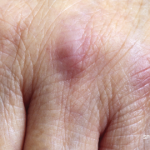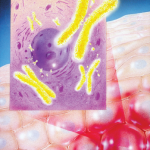 Editor’s note: The 2020 ACR State-of-the-Art Clinical Symposium, which was originally scheduled to be held in New Orleans March 27–29, was moved to an online format to accommodate social distancing requirements during the COVID-19 pandemic.
Editor’s note: The 2020 ACR State-of-the-Art Clinical Symposium, which was originally scheduled to be held in New Orleans March 27–29, was moved to an online format to accommodate social distancing requirements during the COVID-19 pandemic.
ACR BEYOND LIVE—Cancer and autoimmunity have an interesting and complex relationship, one that is bidirectional and important to understand from all perspectives. For example, many of the medications used to treat rheumatic diseases can potentially increase the risk of malignancy (e.g., cyclophosphamide increases the risk of bladder cancer and hematologic malignancies). Similarly, a new class of oncologic treatments, immune checkpoint inhibitors, can lead to immune-related adverse events, such as pneumonitis, inflammatory arthritis and many other autoimmune phenomena.
Some autoimmune diseases, such as scleroderma, can potentiate the effects of cancer treatments (e.g., scleroderma can cause exaggerated, radiation-induced fibrosis of the skin and lungs in patients with a history of breast cancer treated with radiation). Moreover, research in recent years has demonstrated that at least two autoimmune diseases—scleroderma and dermatomyositis—likely have a mechanism of cancer-induced autoimmunity and a high cancer risk that make it essential to think about how best to screen for malignancy in patients with these conditions.
At the 2020 ACR State-of-the-Art Clinical Symposium, Ami Shah, MD, MHS, associate professor of medicine, the Division of Rheumatology, and director of clinical and translational research for the Johns Hopkins Scleroderma Center, Baltimore, focused on these two diseases in a discussion of how to use autoantibodies as tools for cancer risk stratification, how to recognize clinical signs of high cancer risk in these patients and how to approach cancer screening in individuals with new-onset disease.
Antibodies & Risk
In 2014, Joseph et al. published a study involving patients with concurrent cancer and scleroderma. The study revealed somatically mutated genes (specifically, the POLR3A gene) in the patients’ tumors that initiated cellular immunity and cross-reactive humoral immune responses, thereby producing antibodies to RPC1 that reacted to the cancer and are known to play an important role in scleroderma itself. This finding implies that acquired immunity helps control naturally occurring cancers and that collateral damage from this mechanism may spur the development of autoimmune disease, such as scleroderma.1
This field of study has helped provide evidence that several autoantibody patterns in scleroderma—namely, the presence of antibodies to RNA polymerase III, antibodies to RNPC3 and triple negativity (no antibodies to centromere, topoisomerase-1 and RNA polymerase III)—are associated with increased risk of cancer.2
Antibodies to TIF1-γ and NXP-2 in dermatomyositis are also associated with increased risk of malignancy. In a study of over 200 patients with dermatomyositis, 83% with cancer-associated dermatomyositis were identified as having antibodies to either TIF1-γ or NXP-2.3 Some literature also suggests that dermatomyositis patients with antibodies to SAE or HMG-CoA may be at an increased risk of cancer as well, but further study is needed.
In contrast, patients with scleroderma and anti-centromere antibodies appear to be at lower risk of cancer than the general population.2
Dr. Shah noted several clinical findings that should increase a clinician’s concern that a patient may have an autoantibody profile associated with an increased risk of malignancy. For example, patients with antibodies to RNA polymerase III tend to have explosive and diffuse onset of cutaneous involvement of their scleroderma; may develop Raynaud’s phenomenon late in the course of disease; and frequently manifest clinical complications, such as scleroderma renal crisis, gastric antral vascular ectasia (GAVE) or inflammatory myopathy. Similarly, the appearance of an ovoid palatal patch in the mouths of patients with dermatomyositis has been associated with the presence of anti-TIF1-γ (p155) antibodies.4
Other Red Flags
Dr. Shah explained that, in addition to autoantibody and clinical findings that raise suspicion for cancer in patients with scleroderma or dermatomyositis, she also screens for red flag findings, such as:
- Older age at disease onset (i.e., >60 years of age);
- Aggressive or atypical disease, or treatment-unresponsive disease;
- Weight loss and constitutional symptoms that appear out of proportion to disease severity; and
- A patient’s personal or family history of cancer.
The basic approach to history taking and examining all patients should include asking about overt cancer risk factors (e.g., smoking, extensive sun exposure); inquiring if patients are up to date with age-appropriate cancer screening, such as colonoscopy and mammography; and performing a breast exam in female patients and a testicular exam in male patients under the age of 40. Dr. Shah also advises a pelvic exam be performed by a gynecologist or other clinician who can evaluate for pelvic masses or other signs of gynecologic malignancies. In female patients with new-onset scleroderma or dermatomyositis, mammography can be offered beginning at age 40 and can be repeated annually. Prostate-specific antigen (PSA) testing should be done for male patients.
Dr. Shah also stated that, in addition to age-appropriate cancer screening with PAP smear and colonoscopy—as guided by such organizations as the U.S. Preventive Services Task Force (USPSTF)—patients with new disease after the age of 65 may reasonably be offered an additional PAP smear, and patients with disease onset after age 75 could be offered an additional colonoscopy. Transvaginal ultrasound may also be considered in cancer screening for female patients.
Several studies have looked at the most cost-effective and high-yield ways to screen for malignancy via imaging in patients with scleroderma or dermatomyositis. In a retrospective analysis of 400 patients with dermatomyositis, Leatham et al. identified 48 patients with a total of 53 dermatomyositis-associated cancers.5 Twenty-seven of these patients had an undiagnosed malignancy at the time of dermatomyositis diagnosis, and the majority (59%) of these cancers were asymptomatic and detected by computed tomography (CT). These data indicate that blind CT of the chest, abdomen and pelvis may be a high-yield approach to screening for malignancy in dermatomyositis.
In another study of 55 patients with newly diagnosed myositis, whole-body fluorodeoxyglucose-positron emission tomography/CT (FDG-PET/CT) was compared with the results of conventional cancer screening, which included thoracoabdominal CT, mammography, gynecologic examination, ultrasonography and tumor marker analysis. In this study, the positive and negative predictive values for diagnosing occult malignancy were 85.7% and 93.8%, respectively, for FDG-PET/CT and 77.8% and 95.7%, respectively for conventional cancer screening. From this, the authors concluded the performance of a single FDG-PET/CT for diagnosing occult malignancy in patients with myositis was comparable to that of broad conventional screening that involves many more tests.6
In Sum
In concluding her lecture, Dr. Shah urged the audience to think carefully about which patients with rheumatologic diseases are at increased risk of cancer and to use all tools at the clinician’s disposal, including personal and family history, physical exam, autoantibody profiles and clinical disease features to risk-stratify patients for cancer screening.
There may not be a one-size-fits-all model for such screening in rheumatic disease patients, but that is exactly why a thoughtful rheumatologist can be most helpful in guiding patients on this difficult subject.
Jason Liebowitz, MD, completed his fellowship in rheumatology at Johns Hopkins University, Baltimore, where he also earned his medical degree. He is currently in practice with Skylands Medical Group, N.J.
References
- Joseph CG, Darrah E, Shah AA, et al. Association of the autoimmune disease scleroderma with an immunologic response to cancer. Science. 2014 Jan 10;343(6167):152–157.
- Igusa T, Hummers LK, Visvanathan K, et al. Autoantibodies and scleroderma phenotype define subgroups at high-risk and low-risk for cancer. Ann Rheum Dis. 2018 Aug;77(8):1179–1186.
- Fiorentino DF, Chung LS, Christopher-Stine L, et al. Most patients with cancer-associated dermatomyositis have antibodies to nuclear matrix protein NXP-2 or transcription intermediary factor 1γ. Arthritis Rheum. 2013 Nov;65(11):2954–2962.
- Bernet LL, Lewis MA, Rieger KE, et al. Ovoid palatal patch in dermatomyositis: A novel finding associated with anti-TIF1γ (p155) antibodies. JAMA Dermatol. 2016 Sep1;152(9):1049–1051.
- Leatham H, Schadt C, Chisolm S, et al. Evidence supports blind screening for internal malignancy in dermatomyositis: Data from 2 large U.S. dermatology cohorts. Medicine (Baltimore). 2018 Jan;97(2):e9639.
- Selva-O’Callaghan A, Grau JM, Gámez-Cenzano C, et al. Conventional cancer screening versus PET/CT in dermatomyositis/polymyositis. Am J Med. 2010 Jun;123(6):558–562.


